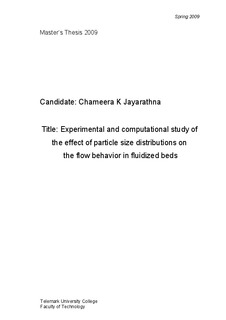| dc.contributor.author | Jayarathna, Chameera K. | |
| dc.date.accessioned | 2014-07-30T08:21:47Z | |
| dc.date.accessioned | 2017-04-19T13:18:09Z | |
| dc.date.available | 2014-07-30T08:21:47Z | |
| dc.date.available | 2017-04-19T13:18:09Z | |
| dc.date.issued | 2009 | |
| dc.identifier.citation | Jayarathna, Chameera K. Experimental and computational study of the effect of particle size distributions on the flow behavior in fluidized beds. Master thesis, Telemark University College, 2009 | |
| dc.identifier.uri | http://hdl.handle.net/11250/2439035 | |
| dc.description.abstract | The aim of the work of this thesis is to study the flow behavior of a fluidized bed with respect to different particle mixtures. The efficiency of the fluidized bed reactors depends on the bubble distribution, bubble size and the bubble velocity in the reactor. The bubble behavior depends on the amount of excess air introduced to the reactor. Set of experiments and simulations are performed related to the study. The experiments are performed in a circular fluidized bed with uniform air distribution. Mixtures of spherical glass particles with different compositions with respective to the size of the particles are used for the experiments. The mixtures consist of two different particle types mainly, which are referred as large and small particles in the thesis. The minimum fluidization velocity, bubble behavior in the bed, pressure distribution in the bed and the bed expansion are observed for the two particle types and their mixtures. As the first part of the computational study, a set of simulations are performed to select the optimum grid size for the mesh to be used for rest of the computational work. The meshes are prepared using commercial software Gambit. The simulations are performed using the commercial software FLUENT 6.3. Two dimensional simulations are selected after comparing the simulations time requirement. The optimum grid size is found as 3x3 mm in a two dimensional bed. As the second part of the computational study, a set of simulations Corresponding simulations are performed using the same conditions as in the experiments. The mean particle diameter of the mixture is used to represent each of the particle mixtures which are used in the experiments. The predicted results from the simulations are compared with the experimental results. Some of the results from this work have accepted to be presented in the modeling and simulation conference, sims50 at Denmark in year 2009. The paper is attached as an appendix. | |
| dc.language.iso | eng | |
| dc.publisher | Høgskolen i Telemark | |
| dc.subject | Bubbling fluidization | |
| dc.subject | Bubble behavior | |
| dc.subject | CFD simulations | |
| dc.subject | Pressure distribution | |
| dc.title | Experimental and computational study of the effect of particle size distributions on the flow behavior in fluidized beds | |
| dc.type | Master thesis | no |
| dc.description.version | Published version | |
| dc.rights.holder | © Copyright The Author. All rights reserved | |
| dc.subject.nsi | 560 | |
